Fun with Magnets Class 6 Extra Questions Science Chapter 13
NCERT Extra Questions for Class 6 Science Chapter 13 Fun with Magnets
Magnetic and non-magnetic materials
Question 1.
Who discovered magnet?
Answer:
An old shepherd who lived on Create Island named Magnes discovered it.
Question 2.
Name the country in which it (magnet) was discovered.
Answer:
Greece.
Question 3.
When was magnetite discovered?
Answer:
Magnetite was discovered around 800 B.C.
Question 4.
What is magnetite called now?
Answer:
Magnetite like materials are called magnets now.
Question 5.
What are magnetic materials (substances)?
Answer:
Materials which get attracted by the magnet are called magnetic materials (substances).
Question 6.
What are non-magnetic substances?
Answer:
Substances which are not attracted by magnet are called non-magnetic substances.
Question 7
Write the names of some non-magnetic substances.
Answer:
Rubber, Cotton, Plastic, Wood, Button, Cloth, etc.
Question 8.
Name the first magnet.
Answer:
Lodestone.
Question 9.
What is lodestone?
Answer:
Lodestone is a type of iron. It bears the properties of magnet.
Question 10.
Make a list of given substances into two groups – magnetic and non¬magnetic.
Answer:
Key, Wood, Glass, Alpin, Chalk, Pencil, Nail, Cup of tea, Book, Rubber, Needle, Fork.table
| Magnetic substances | Non-magnetic substances |
| Key, alpin, nail, needle, fork (because all these stick to the magnet) | Wood, glass, chalk, pencil, cup of tea, book, rubber. (none of these sticks to the magnet) |
Question 11.
What are the properties of a magnet?
Answer:
- It attracts iron pieces towards itself.
- It always aligns itself in the same direction, if left to rotate freely.
- It is composed of oxides of iron (Fe3O4).
Question 12.
What are soft and hard magnetic materials?
Answer:
Soft iron is called soft magnetic material because it loses its magnetism easily. Soft iron is used in making electromagnets.
Steel is called a ‘hard’ magnetic material because it does not lose its magnetism so easily. It is used to make permanent magnets.
Poles of magnet
Question 1.
How many poles are there in a magnet?
Answer:
There are two poles in a magnet, north-pole and south-pole. See Fig. 13.2.

Question 2.
To which part of the magnet do the most of the iron filings (or pins) stick?
Answer:
Most of the iron filings (or pins) stick to the poles, i.e., north and south poles. At these poles of magnet magnetic effect is maximum (See Fig. 13.3).

Question 3.
To which part of the magnet do none or only a few iron filings (or pins) stick?
Answer:
Minimum number of iron filings stick to the middle part of the magnet. Magnet has its magnetic effect least in this part (middle part).
Question 4.
Are both poles of a magnet similar?
Answer:
No, the two poles of a magnet are not similar (alike). Both have different tendency. The pole that points towards the north is called north-pole while the pole pointing always towards the south is called south-pole.
Question 5.
Which is the north-pole of a bar magnet?
Answer:
It is the tip of a bar magnet which points towards the north direction.
Question 6.
Which is the south-pole of a bar magnet?
Answer:
It is the tip of a bar magnet that points towards the south direction.
Question 7.
Why does bar magnet always point in north-south directions?
Answer:
Bar magnet always points in north-south directions when left freely suspended because earth itself behaves like a magnet and north-pole of bar magnet is attracted towards south-pole of earth’s magnet and vice versa.
Question 8.
Where are south and north poles of earth’s magnet?
Answer:
Earth’s magnetic south-pole is near the geographic north-pole and north-pole of earth’s magnet is near geographic south-pole.
Question 9.
Can we isolate north-pole or south-pole?
Answer:
No, we cannot isolate north-pole of a magnet from its south-pole or vice versa. If you break a bar magnet into two halves, you will not get a single north or south pole but two magnets each with its north and south-poles.
Question 10.
Do magnetic poles exist separately like charges? Explain.
Answer:
Magnetic poles do not exist separately like positive and negative charges. This means that it is not possible to isolate a north pole of a magnet from its south pole by cutting the magnet from the middle. Whenever a bar magnet is cut into two halves, we get two new magnets, each with its north and south poles. This will continue indefinitely even if extremely small pieces of bar magnets are obtained. Thus magnetic polest always exist in pairs.
Question 11.
What happens when a pole of a bar magnet say its north-pole is marked with a chalk and suspended freely? What do you observe on rotating the bar magnet?
Answer:
The marked pole comes to rest in north direction. On rotating, after some time, it again comes to rest in north direct0n.
Question 12.
Where are the poles of a circular magnet? How will you find this?
Answer:
Ring type or circular magnet also has two poles.Its exterior and interior parts act like different poles.
To find out the nature of the two poles, we suspend circular magnet with a piece of thread. We bring another magnet near it. Both attract each other. It clearly concludes Fig. 13.10. Circular magnet that one surface of the circular magnet is attracted but the other surface is repelled by the same pole of the other magnet.
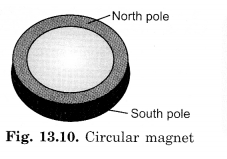
Question 13.
Mark the north-poles of two bar magnets and bring the poles of the magnets near each other, and note down your observations in table.
Answer:
| Poles, facing one another | They are called | We observe |
| North-South | Opposite poles | Attraction |
| North-North | Similar poles | Repulsion |
| South-South | Similar poles | Repulsion |
| South-North | Opposite poles | Attraction |
Question 14.
What will happen to the magnet when we cut it into two pieces?
Answer:
When we cut a bar magnet into two pieces, both these pieces act as magnets and we get two magnets (Fig. 13.11).
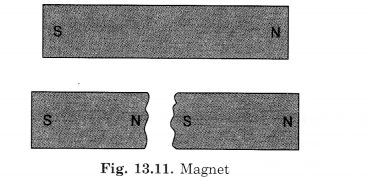
Question 15.
When a bar magnet was brought close to a compass, the orientation of the needle became as shown in figure. Identify the poles on the ends of the bar magnet marked A’ and ‘B’. Explain how you arrived at your answer.
Answer:
Orientation of the needle clearly shows that red marked ‘ end (north-pole) attracts the end of bar magnet marked “A”. It means both these are unlike poles and the end of bar magnet marked “A” is south-pole. End marked ‘B’ is north-pole because like (same) poles repel each other.

Question 16.
Fill in the blanks:
(i) When a suspended magnet comes to rest, one pole always points towards the ………………..
(ii) And the other pole always points towards the …………..
Answer:
(i) North,
(ii) South
Activity 4
Spread some iron filings on a sheet of paper. Now, place a bar magnet on this sheet. What do you observe? Do the iron filings stick all over the magnet?
No, the iron filings will stick only on the poles or the ends of the magnet.
Do you observe that more iron filings get attracted to some parts of the magnet than others (NCERT Fig. 13.7)?
More iron filings get attracted to ends of the magnet where the magnetic force is maximum.
Remove the iron filings sticking to the magnet and repeat the activity. Do you observe any change in the pattern with which the iron filings get attracted by different parts of the magnet?
No, there is no change in the pattern.
Finding Directions
Question 1.
In which direction does freely suspended magnet rest?
Answer:
A freely suspended magnet always points in the north-south direction.
Question 2.
How did we come to know that magnet is helpful to find (detect) directions?
Answer:
About 800 years ago, Chinese saw that a hanging lodestone always comes to rest in a particular direction i.e., north-south. Therefore, they came to know about finding the direction with the help of lodestone.
Question 3.
Why is compass needle kept in a closed glass vessel?
Answer:
Compass needle is a small and thin magnet used to find the direction. If it is kept in open, it may deflect in any direction due to pressure exerted by air. So to know right direction, it is kept covered by glass covering.
Question 4.
Does the compass needle point in different directions?
Answer:
The compass needle has a magnetic needle closed in a glass covering. The needle can rotate on its pin pointed base. Its red marked end always indicates towards the north direction. It always rests in north-south directions. We use it to find out the direction.
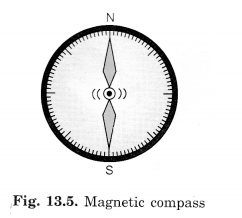
Question 5.
Hang a bar magnet with a thread on a stand and rotate the base of stand. What will happen?
Answer:
The direction of bar magnet is not changed as we rotate the stand. It is because a freely suspended magnet comes to rest in particular direction, i.e., north-south directions. In this activity, only stand changes its direction (See Fig. 12.6)
Question 6.
How do the shipmen find the direction even when north pointing pole star is not visible?
Answer:
Shipmen during navigation can find the direction with the help of magnetic needle. This is believed to be first used by Chinese.
Make Your Own Magnet
Question 1.
Can an ordinary vessel (lota) be magnetised?
Answer:
Yes, to magnetise ordinary vessel, it would have to be buried in the earth for many years.
Question 2.
Can a magnet be demagnetised? How?
Answer:
Yes, a magnet can be demagnetised:
- By packing like poles of two magnets in same direction.
- By hammering the magnet hard.
- By heating the magnet strongly.
Question 3.
How should two-bar magnets be kept?
Answer:
After using it, two-bar magnets should be placed inside a wooden box so that:
- the poles of two magnets lie opposite to each other.
- a wooden piece should be kept between the two magnets.
- metallic caps should be put on the poles, otherwise they will attract other magnetic objects.
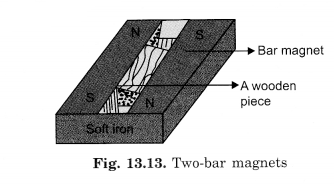
Activity 6.
Magnetise an iron needle using a bar tnagnet. Now, insert the magnetised needle through a small piece of cork or foam. Let the cork float in water in a bowl or a tub. Make sure that the needle does not touch the water (Fig.). Your compass is now ready to work.
Make a note of the direction in which the needle points when the cork is floating. Rotate the cork, with the needle fixed in it, in different directions. Note the direction in which the needle points when the cork begins to float again without rotating. Does the needle always point in the same direction, when the cork stops rotating ?
Yes, the needle always points towards the north when the cork stops rotating.

Attraction And Repulsion Between Magnets
Question 1.
What happens when similar poles come close to each other?
Answer:
They repel each other.
Question 2.
When do two magnets attract each other?
Answer:
Two magnets attract each other when their unlike (opposite) poles come close to each other.
Question 3.
How can you show that unlike poles attract each other while like poles repel each other?
Answer:
Suspend a magnet on a stand with the help of a string. Now it rests in N-S directions. Take another magnet which has been marked N-S on it and bring N-pole of this magnet near the N-pole of the suspended magnet. You will find that the suspended magnet rotates and moves away showing that like poles repel each other [Fig 13.6 (6)]. The same can be repeated by bringing south-pole of one magnet near south-pole of suspended magnet.
Now you must have found that during the above experiment, south-pole comes towards north-pole and vice versa. It can be repeated by bringing south-pole near a north-pole and north-pole near south-pole of suspended magnet. You will find that unlike poles attract each other [Fig. 13.6. (a)].
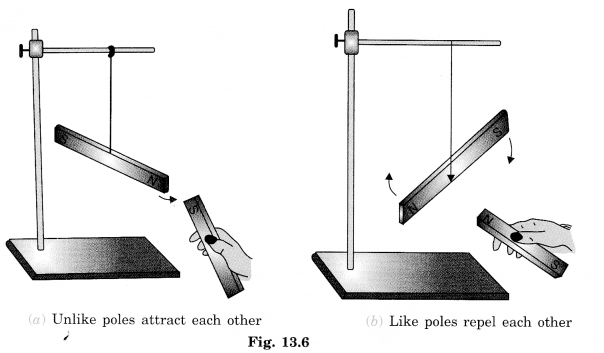
Question 4.
Bhawana witnessed an interesting game at the fair. A duck was floating in a tub. When a plate containing some grains of rice was brought close to the duck, the duck moved towards the plate. But, when a plate containing some pebbles was brought close to the duck, it moved away from the plate. Explain how this could have been possible.
Answer:
This game is based on the plate containing rice which may have magnet attached to its bottom. The magnet is fitted in such a way that its north-pole points towards rice grains, while south-pole indicates towards pebbles. A magnet (bar magnet) may also be fitted in the bottom of the duck, where south-pole points towards mouth and north-pole towards tail of the duck.
When the rice portion of the plate is brought closer to the duck, the duck moves towards rice grains because unlike poles of two magnets attract each other. In second situation, same (like) poles repel each other. So the duck moves away.
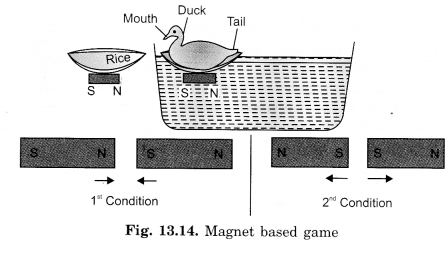
Question 5.
What do you mean by magnetic field?
Answer:
The region around the magnet where its magnetic influence can be felt is called the magnetic field of the magnet.
Question 6.
What is MRI?
Answer:
Magnetic Resonance Imaging (MRI) is a medical diagnostic technique which uses the magnetic field inside the body for obtaining images of different parts of the body.
Objective Type Questions
Question 1.
Match the following items given in Column A with that in Column B:
| Column A | Column B |
| (a) Magnetite | (i) Non-magnetic substances |
| (b) Iron, nickel, cobalt | (ii) Used to find out N-S directions |
| (c) Leather, plastic, wax | (iii) Attract each other |
| (d) Lodestone | (iv) Natural magnet |
| (e) Compass | (v) Repel each other |
| (f) Like poles of two magnets | (vi) Discovered magnet incidently |
| (g) Opposite poles of two magnets | (vii) Magnetic, substances |
| (h) Magnus | (viii) Name of first magnet |
Answer:
| Column A | Column B |
| (a) Magnetite | (iv) Natural magnet |
| (b) Iron, nickel, cobalt | (vii) Magnetic substances |
| (c) Leather, plastic, wax | (i) Non-magnetic substances |
| (d) Lodestone | (viii) Name of first magnet |
| (e) Compass | (ii) Used to find out N-S directions |
| (f) Like poles of two magnets | (v) Repel each other |
| (g) Opposite poles of two magnets | (iii)Attract each other |
| (h) Magnus | (vi) Discovered magnet incidently |
Question 2.
Fill in the blanks with appropriate words:
- When north-pole of one magnet is brought near the …………….. of another magnet, they attract one another.
- When the north-pole of one magnet is brought close to the …………… of another magnet, they repel each other.
- Similar poles of two magnets …………………. one another.
- A compass needle always points in a direction …………………….
- Stickers with pieces of magnet inside them easily stick to ………………… surfaces like the doors of refrigerator.
- Materials which get ……………….. towards magnet are known as magnetic.
- The ……………………… of magnet where maximum iron filings get clung, ape known as ………………..
- Magnetic effect can pass through …………………………
- We should not drop the magnet, shouldn’t heat it, shouldn’t …………………. it.
- The south pole of the earth’s magnet is near the geographical ………………… pole.
- Magnetic poles always …………………….. in pairs.
- Hammering destroys the ………………… of small magnets inside.
Answer:
- south pole
- north pole
- repel
- north-south
- iron
- attracted
- ends, poles
- screen
- hammer
- north
- exist
- magnetism
Question 3.
State whether the statements given below are True or False:
- Lodestone is composed of oxides of iron.
- North and south poles are found to exist separately.
- Magnetite doesn’t show magnetic properties.
- If we cut a bar magnet in two halves we will have two magnets.
- Heat can destroy magnetic properties of a magnet.
- Magnets are made up of different materials and in different shapes.
- Compass needle is made of a magnet.
- There is a maximum attraction in middle of a bar magnet.
Answer:
- True
- False
- False
- True
- True
- True
- True
- False
Question 4.
Choose the correct option in the following questions:
(i) Which is an example of a magnetic substance?
(a) Iron
(b) Nickel
(c) Cobalt
(d) All of these
Answer:
(d) All of these are attracted towards a magnet.
(ii) Magnets have a shape
(a) cylindrical
(b) ball ended
(c) horse shoe
(d) all of these
Answer:
(d) Magnets may be of various shapes including bar magnets.
(iii) When a bar magnet is brought near iron dust, most of the dust sticks
(a) near the middle
(b) equally everywhere
(c) near two ends
(d) at the middle and ends
Answer:
(c) Magnetic field intensity is maximum at the poles of a bar magnet.
(iv) A freely suspended bar magnet rests in
(a) north-south directions
(b) east-west directions
(c) upside down
(d) any direction by chance
Answer:
(a) A bar magnet always rests in N-S directions when suspended freely.
(v) Attraction is seen between the poles of two bar magnets in the case of
(a) N-pole of one magnet with N-pole of other
(b) N-pole of one magnet with S-pole of other
(c) S-pole of one magnet with S-pole of other
(d) all of these cases will show attraction
Answer:
(b) Unlike poles attract and like poles repel each other.
(vi) Which is a natural magnet?
(a) Magnetite
(b) Haemetite
(c) Bakelite
(d) Copper
Answer:
(a) Magnetite is a natural magnet.
(vii) Choose the wrong statement
(a) Heat can destroy magnetic properties of a magnet. ‘
(b) Magnets are made up of different materials and different shapes.
(c) There is a maximum attraction in middle of a magnet.
(d) Magnetite does not show magnetic properties.
Answer:
(d) Magnetite does not show magnetic properties.
(viii) The magnetic properties of a magnet cannot be destroyed by
(a) hammering
(b) heating
(c) dropping on a hard surface
(d) boiling
Answer:
(d) Magnetic properties of a magnet cannot be destroyed by boiling, because magnetic properties are destroyed by hammering, dropping on hard surface and by heating.
(ix) Which two ends of a magnet are called magnetic poles?
(a) North pole
(b) South pole
(c) North and south pole
(d) Self demagnetisation
Answer:
(c) Magnetic poles (North pole and South pole)
(x) Magnets attract
(a) wood
(b) plastic
(c) paper
(d) iron
Answer:
(d) Iron is attracted by magnet.
Extra Questions for Class 6 Science
<!–
–>